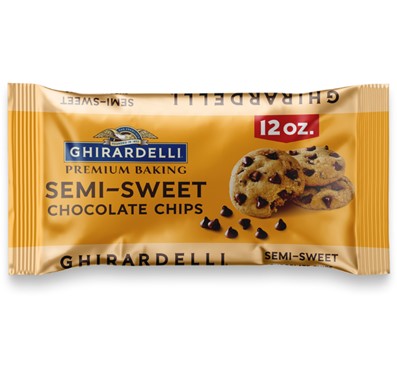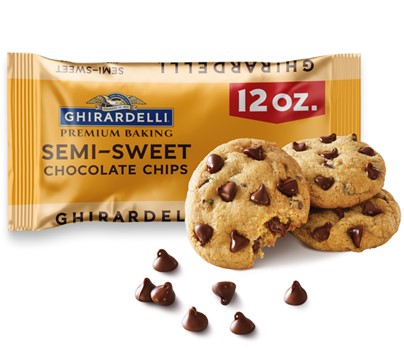For Ghirardelli Chocolate Co. to update its product detail page with a new image, it could take a month to go from idea, photo shoot and editing to live, says Pam Perino, ecommerce content operations and development manager at Ghirardelli.
But with the new generative artificial intelligence tools available to brands, it could be “10 to 100 times faster than the manual process for image creation,” Perino says.
“That’s a great opportunity to do something quickly versus having to wait for a photoshoot or having to use stock images,” Perino says.
But right now, Perino is not confident generative AI is ready to create images from scratch for its brand. For example, if the brand were to say, “create a Ghirardelli logo,” Perino is doubtful the AI would get the logo exactly right.
And getting it exactly right is critical.
“We have very high expectations for how our images to look,” she says.
Where Ghirardelli Chocolate Co. is currently using generative AI is for editing images on its product detail pages. On a recent photo shoot for its new no-sugar-added baking chips, the brand used generative AI to remove part of a napkin in the image and fill in the background with a part of the product’s bag.
Ghirardelli uses AI to decide how to tweak product images
But editing is as far as Ghirardelli will let the generative AI create. The brand will, however, use artificial intelligence to help guide its decisions about what images should look like.
Since Q2 2023, the brand has used image-scoring software Vizit to evaluate its images. Vizit uses artificial intelligence to analyze how impactful an image is and to catalog the attributes of the image. Based on publicly available metrics, such as likes or shares on a social media website, Vizit can analyze and score an image, and suggest tweaks.
The technology is helpful when deciding which images to use on product detail pages and the changes Ghirardelli might make so the images perform better, Perino says. For example, Vizit’s technology scored many of its closely cropped baking images higher than those that were zoomed out, and so those are the ones Ghirardelli will use on its page, Perino says.
Instead of having a 2D static image of its chocolate chip bag, another tweak Vizit suggested was to have the image on the package “burst” off the package for more of a 3D look. In the same image, Vizit also suggested to make the text larger for “12 oz.” With these tweaks, Vizit scored the image at a 95, meaning it has a high likelihood of converting shoppers, compared with the image without these changes, which it scored at a 6.

Vizit’s AI technology scores Ghirardelli’s package image above lower compared to the one below with the chocolate chips bursting off the package and the 12 oz. bag size in a larger text size.

Perino did not share any data about increases in conversion since using Vizit’s technology. Vizit says its clients typically have a 15%-25% increase in conversion rate when using the images it suggests, says CEO and founder Jehan Hamedi. Hamedi did not share how many clients it has, but in 2021, he told Digital Commerce 360 that Vizit has less than 100 brands that use its technology, including padlock products MasterLock, shoe brand Reebok, and food brands OceanSpray, Tyson, Cliff Bars and Mars Petcare.
Brands jump on using AI technology
While Vizit’s technology doesn’t use generative AI, it uses artificial intelligence to help brands more effectively and more efficiently increase sales, Hamedi says.
“Where the rubber really meets the road for these businesses is how AI and these tool sets actually help drive sales,” Hamedi says. “Because at the end of the day, every brand is in business and exists to sell products and create positive outcomes.”
With the popularization of OpenAI’s ChatGPT generative AI chatbot, Hamedi says many in the ecommerce industry are talking about AI and becoming more educated on how AI can be practical for businesses.
“It’s created urgency among our customers about how to adopt AI because it’s a new arms race,” Hamedi says.
Ghirardelli’s future applications of generative AI
Ghirardelli has plans to use generative AI in other ways in the future, such as creating product copy on the product detail page and updating product copy with relevant search engine optimization (SEO) words and for creating images, Perino says.
“We are excited about artificial intelligence as a digital technology and how can it help us be faster and more nimble, and how do we update, create and improve our content,” Perino says.
For example, Ghirardelli wants its product detail pages to be updated with seasonal SEO words, such as chocolate for Halloween, Christmas, Mother’s Day and graduation. Today, the brand manually updates this copy to ensure the detail pages can show up high in search results.
Ghirardelli, however, finds that generative AI is not yet refined enough to have mastered brand voice and tone, and it is waiting until it improves before having a tool write copy to go live on its site.
“We’re excited,” Perino says. “It’s such an interesting time with AI right now, but it needs to be tempered with a bit of caution and guardrails.”
Brands should use caution with generative AI right now
That’s particularly true for a food manufacturer like Ghirardelli, given strict government regulations about food and beverages. For example, Ghirardelli can’t call some of its products that might be commonly referred to as “white chocolate,” because they do not contain cocoa and are not technically chocolate. Instead, it labels products as “white baking chips” or “vanilla flavored.” Perino isn’t confident that generative AI would understand this distinction.
At this early stage of generative AI, brands should have a cautious approach to using the technology, says Kassi Socha, director analyst, retail, at research firm Gartner. If brands are using generative AI today in their business to create content, she suggests still having manual oversight before anything is published.
“Generative AI can suggest copy and suggest opportunities, but there still needs to be a team in place to validate some of the outputs,” Socha says. “With any machine learning or artificial intelligence, it’s only as good as the inputs, and it take time to optimize and learn.”
Do you rank in our database?
Submit your data and we’ll see where you fit in our next ranking update.
Sign up
Stay on top of the latest developments in the ecommerce industry. Sign up for a complimentary subscription to Digital Commerce 360 Retail News. Follow us on LinkedIn, Twitter and Facebook. Be the first to know when Digital Commerce 360 publishes news content.
Favorite